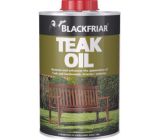
Outdoor Wood Paint
-

Blackfriar Teak Oil
From:£5.95(inc VAT)multiple sizes
Which is the best paint to use on exterior wood?
When painting exterior wood, we recommend using a product like Cuprinol Garden Shades or Dulux Gloss Tinted Colours. Both of these products offer the long last protection needed for exterior surfaces, and are hard wearing enough to stand the test of time. Depending on the type of surface you are painting, it may also be helpful to check out what anti-mould paints are available.
What is the best paint to use outdoors on concrete?
If you are looking to paint an exterior concrete surface, you are best off using a specialist masonry paint. These paints provide an extra layer of protection and are often self-priming, meaning the only pre-paint prep you need to do is to clean your surface to remove any dirt.
How to paint exterior wood
Be mindful of the weather and your external environment before beginning to paint some exterior wood. Choose a fairly pleasant day without too much sun, and be sure to check that your neighbours aren’t going to cut their grass or hedges. The last thing you want is dust or pollen particles sticking to your newly painted surfaces and ruining the finish.
If your wood has been painted before, you should strip away any old paint and apply an undercoat paint before starting your main coat. If this is the first time the wood will be painted, you’ll need to add a coat of wood primer to prepare the wood for painting.
You’ll need to apply at least two coats of paint to get a high quality finish with brighter, longer-lasting colour. For something like a garden bench you’ll be best off using a traditional paintbrush, but for a larger surface like fence panels you may want to use a roller brush or spray gun to speed the process up and ensure smoother coverage. Build up the coats in thin layers rather than applying it thickly, as this will avoid causing the paint to run. Be sure to wait until your first coat is fully dry before beginning to apply a second.

